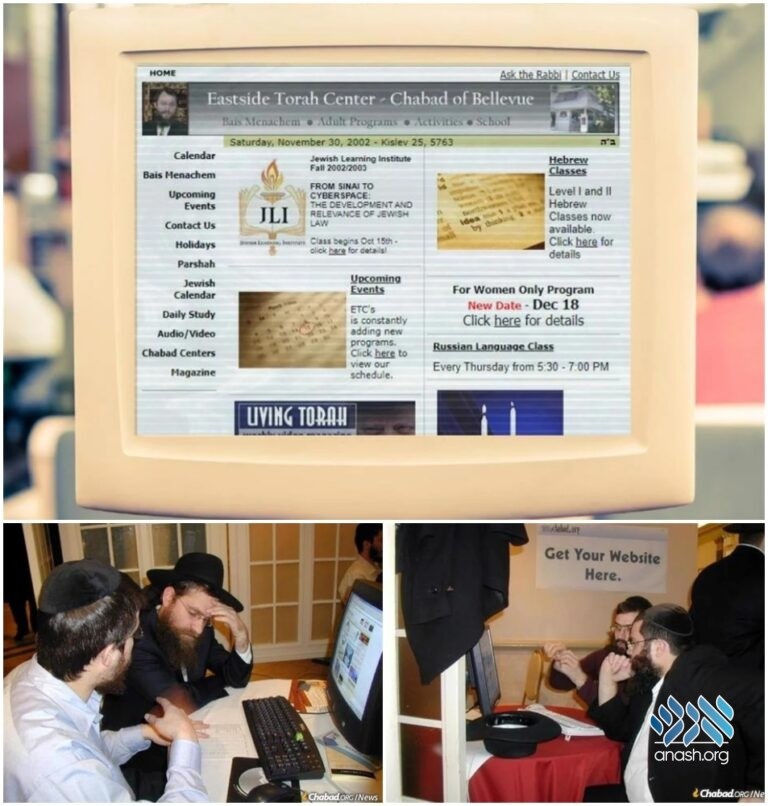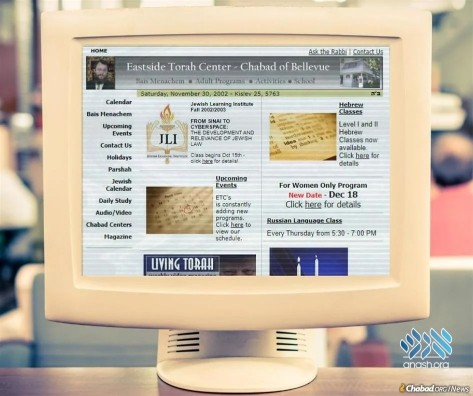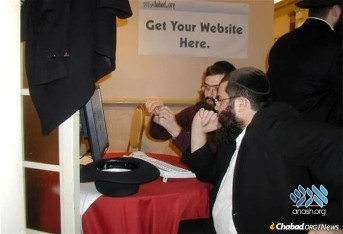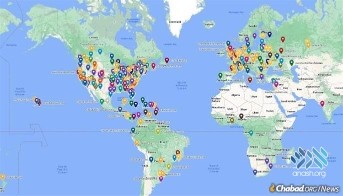Twenty years ago, a group of Lubavitchers created the ChabadOne platform to give shluchim to have their own sites with minimal effort. Today, the platform is used in 1,500 locations and in 16 languages.
By Mendel Super – Chabad.org
Before there was Wix, Weebly, WordPress and the rest of the popular, user-friendly website builders, creating your own professional-looking website took a team of coders and designers—a complex, cumbersome and expensive process that was beyond the capacity of most people in 2002 who wanted to establish a presence on the web. One of the earliest user-friendly site builders that could be used without any IT or technical background was Chabad.org’s Chabad One platform, which offered Chabad-Lubavitch communities around the world a turnkey solution to create a powerful, modern online presence.
“These were the early days of the internet; if you wanted a site, you had to build it from scratch,” recalls Rabbi Moshe Rosenberg, director of ChabadOne, which is celebrating its 20th anniversary this week. “We built a platform that enabled local Jewish communities to have their own powerful site, years before anyone else.”
Today, almost 1,500 Chabad houses around the world have a site powered by ChabadOne in 16 languages in which more than 5 million interactions have been registered for everything from Passover Seder registrations to kosher-food orders and Hebrew-school enrollments.
Chabad.org, the mothership of these sites, was one of the first 500 domains registered and websites built back in 1993, when even Yahoo! and Amazon didn’t exist, “Chabad” couldn’t be Googled for another five years, and “Chabad near me” for many years after that.
The site was the life’s work and legacy of the late Rabbi Yosef Yitzchak Kazen who had begun using the 1980s’-era BBS, or Bulletin Board System, to send Torah content around the world and operated the first online “Ask the Rabbi” service on the early iterations of the internet.
By the mid-1990s, the team grew, and the site began to expand with specialized holiday sites, video and audio content, and many interactive features. From the beginning, Chabad.org hosted an Online directory of Chabad houses that grew significantly as more and more young women and men joined the ranks of the Rebbe’s emissaries.
“People often think my father’s vision was just to use the internet as a means to broadcast Jewish teachings,” says one of Kazen’s sons, Rabbi Peretz Kazen, today director of Chabad of Baton Rouge, LA. “But really it was something much more expansive. It was a new paradigm of connectivity. It really included all emerging technologies. He wanted to be at the forefront of using them all, and for the last decade of his life, that’s what he did.”
As early as the 1990s, Kazen had a vision for each Chabad center to have its unique webpage, where they could list local information, such as a description of the center, programs offered, photos, and other pertinent information and announcements that could aid visitors and locals alike. It wasn’t until almost a decade later—thanks to advances in internet technology— that his vision could begin to materialize.
Working from a hospital bed in the months before his passing, Kazen and Shimon Laber developed plans for an expansion and restructuring of Chabad’s presence on the web that would include customization by local Chabad-Lubavitch shluchim around the world. In the month before his passing in December 1998, Merkos L’Inyonei Chinuch, the educational arm of Chabad-Lubavitch announced it would be launching “a major Internet project” in coordination with “Chabad Lubavitch in Cyberspace”, utilizing “state-of-the-art programming and design values” to help each Chabad house have its own page on the central Chabad.org platform.
A survey of Chabad emissaries about the new project revealed that while it would be useful for them to have an attractive local page, people would have no reason to come back without frequent updates to the content, offering readers inspirational and informative new articles and features to draw them in.
Following Kazen’s passing at the age of 44, responsibility for Chabad’s presence on the web was given to the newly-named Chabad.org under the leadership of Rabbi Zalman Shmotkin. Driven by Rabbi Kazen’s vision, both the technological capacities and editorial content continued to grow, month-by-month.
The new project’s in-person launch began in November 1999 at the Kinus Hashluchim. At a computer bank manned by Rosenberg and tech-savvy Chabad.org staff, shluchim were given a hands-on demonstration of how much the new, localized pages had to offer. Over the next few years, adoption by Chabad centers around the world took off, with dozens of Chabad centers creating their own pages each month. With the growing popularity of these customized listings, there was a demand by many local centers for their own, dedicated website under their own web address.
In the summer of 2002, Chabad.org finally launched the ChabadOne platform, at the time known as MyChabad.org, and filled that need by offering fully customizable websites to all Chabad centers, with their own domains and web publishing tools.
“We had one of those original Chabad.org ‘local center’ pages,” recalls Rabbi Chaim Lazaroff of Chabad Lubavitch of Texas. “Even before that became available, we had created some kind of web page, but it was primitive even for those days.” Lazaroff recognized that life was going more and more online, and the need for a full website was “almost like having a phone or fax machine. People were beginning to look for us and expect to find us online.”
“Chabad. org-powered websites were way ahead of their time,” he says. “Nothing came close to competing with them.”
Rabbi Mendy Deitsch, director of Chabad of the East Valley in Chandler, Ariz., couldn’t agree more. “As a student, I had heard Rabbi Kazen enthusiastically talking about what Chabad was doing online, but it was a foreign concept to me then.” But as soon as Deitsch founded Chabad of Chandler in 1997, he knew he needed an online presence. He found a community member to create a webpage for him, but “we soon realized the limitations we had in producing good content.” Everything had to be entered manually into that early website, including all the Shabbat and holiday times, and the site required immense effort to maintain.
Chandler is home to tech giants Intel and Motorola, so the community was already online in the early days. Deitsch knew he needed something more sophisticated and when Chabad.org introduced their site builder, he adopted it immediately. “It was tremendous,” he reminisces. “Right away, we had a powerful site with all of Chabad.org’s content, and as the web has evolved, the ChabadOne team helped us keep our site up with the current tech and trends.”
“ChabadOne was built to serve the needs of diverse Jewish communities around the world, seamlessly blending local information with Chabad.org’s best content,” explains Rosenberg.
The consistency of the seamless blend of Chabad experience tailored to each community is not lost on others. Gary Wexler, a retired marketing professor at the Annenberg School for Communication and Journalism at the University of Southern California, sees the power of ChabadOne sites as an expression of the Chabad movement’s strength, bringing timeless shared Judaism to people in a way that speaks to the needs of each individual Jew.
“Chabad doesn’t look at a Jew and say ‘He’s this kind of Jew or she’s that kind of Jew’; Chabad looks at a Jew and says ‘A Jew is a Jew,’ ” says Wexler. While contextualizing information in ways that speak to local communities, the platform also is “saying ‘We are Chabad.’ Not just Chabad of Tashkent or Chabad of Buenos Aires—we’re in all these places, but we are Chabad.”
Wexler adds that first impressions are often created before a new community member walks through the doors, based on the website experience.
The best-in-class experience that made ChabadOne stand out 20 years ago still holds true today, and ChabadOne became the center of operations for local Chabad centers around the world.
Instead of using one platform for their website, another for their emails, and another—usually pricey—CRM (customer relationship management) software package, ChabadOne has integrated these services into one seamless product, says Rosenberg. “Pictures featured in one part of the site can also be featured on our emailing platform, and data submitted in one place is synced with our CRM. It’s a holistic experience that saves valuable resources and that seamlessly moves the complex data management to the background, allowing the Chabad emissaries to focus on what they do best: Connecting to and inspiring other Jews.”
Behind the product itself, a large network of reliable support is provided by a team working around the clock in multiple time zones. “At any given time, there are eight support team members available to deal with questions and issues that may arise,” says Rosenberg, “and our technology team is always working on new site improvements and updates.”
This devotion to providing for the local needs of centers around the world has been particularly important when it comes to language. “When, in 2008, we saw we needed a website in Estonian, in addition to our English and Russian sites, ChabadOne was the only one who could offer that,” says Rabbi Shmuel Kot, director of Chabad-Lubavitch of Estonia. The Estonian language is used by only a million people—roughly the same number of Yiddish speakers worldwide—but ChabadOne’s programmers made the entire website platform available in Estonian. It was a huge undertaking, recalls Rosenberg, which included enabling the entire platform to be language-aware and translating hundreds of terms into Estonian so that visitors feel like they’re using a site made for them and in their own language—not a site operated in English with just several pages translated into Estonian.
“Having a multilingual site has been a game-changer,” says Kot. “We have a lot of content in Estonian and Russian hosted on our site, and community members listen to Torah classes there and read about Judaism, especially around the holidays.” Even the local government gets their information about Judaism—often pertaining to Jewish servicemen, government employees, or prisoners—from Chabad’s Estonian site.
Language may be the most immediately apparent localization of the site, but in the back-end, ChabadOne’s developers constantly work with local Chabad communities to optimize their operations. For example, when users submit a donation to their local Chabad center, the payment processing varies by country. In South Africa, where the banking infrastructure is less connected to Western banking systems, ChabadOne worked to integrate a platform that would accept online donations designed specifically for their locale. In Israel, where there are additional regulations for processing payments, the developers customized the sites to accommodate them.
The sites are used by different demographics in various ways. While a Chabad center in a touristy destination may be offering information on local Shabbat-friendly hotels near their center, as well as kosher catering options, a center with young families will have an entire Hebrew-school site for enrollment, registration, and updates.
When Ayelet Hager, a young woman from Teaneck, N.J., missed a connecting flight and was stranded in Copenhagen, Denmark, overnight, she turned to Chabad.org’s Directory listing, which pointed her to Chabad of Denmark’s website, where she made contact with Rochel Loewenthal, co-director of Chabad of Denmark. “Before I even had a chance to ask where I could buy kosher food, the Rebbetzin invited us for dinner—no small deal as there were six of us. She hosted us and sent us back with sandwiches for our flight home.”
“We use the full suite of ChabadOne tools,” says Rabbi Dovid Birk, program director at Chabad of Ithaca, serving Cornell University. “It’s important that Chabad has an attractive site. We update info regularly for students and parents, and all our events are RSVP’d there.” The website is a central source of Torah content for Jewish students and faculty at Cornell, and Birk sees a lot of traffic from prospective students and their parents as they research their options, while Deitsch in Chandler and Kot in Estonia both say that their main users are local community members.
“It’s a fantastic resource to have access to our own branding and customization,” says Lazaroff from Texas. “There’s no way we could produce something like this on our own. The ability to reach our community with local information and interaction of every kind and to provide them with the vast and rich Torah content uniquely on Chabad.org doesn’t exist anywhere else.”
Reprinted with permission from Chabad.org.





Discussion
In keeping in line with the Rabbonim's policies for websites, we do not allow comments. However, our Rabbonim have approved of including input on articles of substance (Torah, history, memories etc.)
We appreciate your feedback. If you have any additional information to contribute to this article, it will be added below.